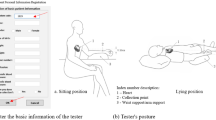Abstract
With the view to set up the oriental pulse database as well as objective diagnosis standards, this study has designed and manufactured a digital pulse diagnosis system that uses a high-performance microprocessor on the basis of systematic pulse diagnosis methodology. The algorithm for extracting significant points has been proposed to precisely interpret the pulse signals that have various kinds of noises, and pulse measurement tests were conducted on many patients at a hospital. Much of the clinical data attained by the digital pulse diagnosis system has been compared with the clinical findings made by the doctors in charge of patients. As a result of this comparison and analysis, the study has found out that the two findings showed almost identical opinions. On this basis, an objective diagnostic parameter clinical diagnosis has been presented.
















Similar content being viewed by others
References
Sik, H. W., The Yellow Emperor’s classic of internal medicine SOMUN. Traditional Culture Research Association: Korea, 1992.
Back, H. S., Oriental pulse diagnostics. Electro-Pulse Graph Research Association: Korea, 1995.
Lee, J. Y., and Lin, J. C., A microprocessor-based noninvasive arterial pulse wave analyzer. IEEE Trans. Biomed. Eng. 22:57–60, 1980.
Richard, A., Principles of biomedical instrumentation and measurement. Macmillan Publishing Company: USA, 1991 (ISBN 0-02-946562-1).
Prior, A. J., Peck, K., Davies, P., and Beevers, D. G., Clinical evaluation of the sphygmomat 2 semiautomatic blood pressure monitor. J. Med. Eng. Technol. 14(6):250–253, 1990.
Lu, W. A., Lin, Y. Y., Lin, W., and Wang, W. K., Pulse analysis of patients with severe liver problems. IEEE Eng. Med. Biol. 18(1):73–75, 1999.
Willis, J. T., Biomedical digital signal processing. Prentice-Hall: Englewood Cliffs, NJ, 1993 (ISBN 0-13-143736-4).
Lee, J. Y., Kim, J. H., and Lee, M. H., Design of digital hardware system for pulse signals. J. Med. Syst. 25(6):385–394, 2001.
Chrales, W. T., Discrete random signals and statistical signal processing. Prentice-Hall: International Editions, NJ, 1992 (ISBN 0-13-217985-7).
Marshall, R. J., The determination of peaks in biological waveforms. Comput. Biomed. Res. 19:319–329, 1986.
Dumpala, S. R., Reddy, S. N. and Sarma, S. K., An algorithm for the detection of peaks in biological signals. Comput. Programs in Biomed. 14:249–256, 1982.
Gordone, E. C., Signal and linear system analysis. Houghton Mifflin Company: Boston, MA, 1992 (ISBN 0-395-51538-6).
Author information
Authors and Affiliations
Corresponding author
Rights and permissions
About this article
Cite this article
Lee, J. The Systematical Analysis of Oriental Pulse Waveform: A Practical Approach. J Med Syst 32, 9–15 (2008). https://doi.org/10.1007/s10916-007-9101-0
Received:
Accepted:
Published:
Issue Date:
DOI: https://doi.org/10.1007/s10916-007-9101-0




